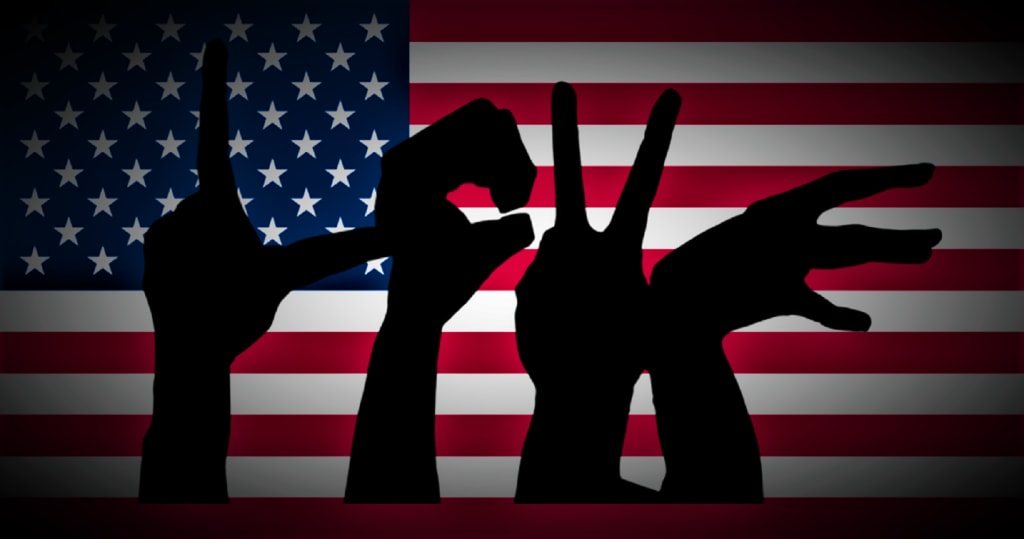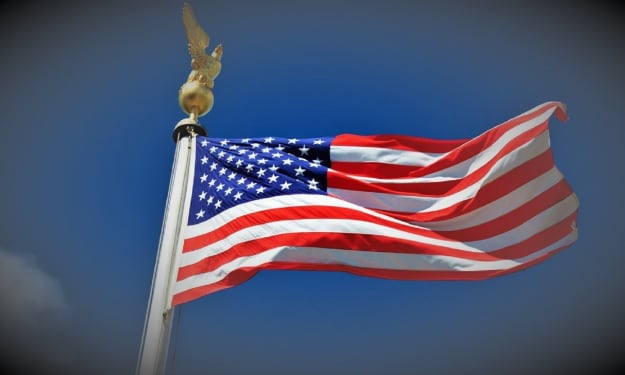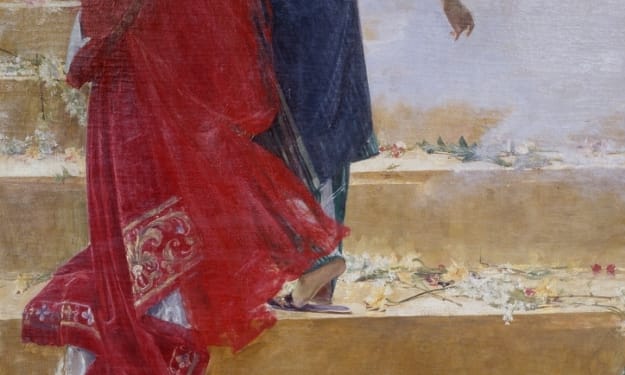Church, State, and Human Rights
Thoughts on Independence Day

I believe strongly in the separation of church and state. It is particularly imperative that the United States does not become a theocracy. That is, we do not and should not have a state religion. We have the constitutional right to follow the religion/spirituality of our choice or none at all.
It is also important that religious institutions not become involved in partisan politics. A preacher should never stand in the pulpit and tell their congregation who to vote for. Each individual should use their hearts, minds, and conscience to vote for the person who they feel best represents them.
This is the only way we continue to have a government that is “of the people, by the people, and for the people.”
In some ways, this voting by conscience intersects with religious conviction. After all, what we believe about divinity and right living is an integral part of who we are. This means that our conscience is heavily affected by our world view, and we make our judgments and choices based on what we believe is right. Of course, this affects our voting.
There is nothing wrong with this, nor is it precluded by the separation of church and state. We are individual parts of “the people” and together we vote for the representatives who meet the most points of our criteria of what is right. If the system works the way it should, the individuals voted into office will meet the criteria of rightness that is held by the majority of voters.
Voting is not meant to be a popularity contest between personalities, but a conscensus of the opinions of those who are running based on the important issues of the day. These issues are what we are voting on, and they are also the area to which we bring our conscience.
Our sense of right and wrong and our spiritual and religious conviction are resident in our conscience. If we are religious or spiritual people, our opinions on these issues are informed by our spiritual lives. This is where the preachers have an influence, whether it be good or bad.
In most cases, the issues in question are related to social justice. How do we treat one another? Who do we include? Who do we exclude? What stance do we represent?
I am ordained in an Interspiritual church which has its roots in progressive, inclusive Christianity. Into that, we bring complementary teachings and practices from other traditions which we as individuals have experienced and taken part in. In this way, we seek to learn the teachings that bring us together across those traditions while continuing to honor the rights of others to practice and believe in their own way.
Out of this, we find that social justice is often an important component of our spiritual lives. With this in mind, I looked into some U.S. history in relation to social justice. Specifically, I wanted to see what our “founding fathers” believed about equality at the time our nation was created. What follows is a short collection of facts about some of the men who led the early U.S. government.
Need I point out the fact that they were all men?
I’ll include a few points of history over the past 247 years since the founding of our nation. We’ll start by reading the beginning of the Declaration of Independence. This is the founding document of these United States.
When in the Course of human events it becomes necessary for one people to dissolve the political bands which have connected them with another and to assume among the powers of the earth, the separate and equal station to which the Laws of Nature and of Nature’s God entitle them, a decent respect to the opinions of mankind requires that they should declare the causes which impel them to the separation. We hold these truths to be self-evident, that all men are created equal, that they are endowed by their Creator with certain unalienable Rights, that among these are Life, Liberty and the pursuit of Happiness….And for the support of this Declaration, with a firm reliance on the protection of Divine Providence, we mutually pledge to each other our Lives, our Fortunes, and our sacred Honor.
Slavery existed and was protected by law in all 13 American colonies when they declared their independence from Great Britain in 1776. Only 13 of the 56 men who signed the Declaration of Independence did not own slaves.
While a committee of individuals worked together to edit and perfect the Declaration, the initial draft was written by Thomas Jefferson, a slaveholder.
In his 1775 treatise, Taxation No Tyranny, British author Dr. Samuel Johnson rhetorically asked, “How is it that we hear the loudest yelps for liberty among the drivers of negroes?”
The signers of the Declaration who did not own slaves also tended to be well-to-do, so it was by choice that they did not trade in human lives for the sake of labor. The 13 who did not own slaves were: John Adams, Samuel Adams, George Clymer, William Ellery, Elbridge Gerry, Samuel Huntington, Thomas McKean, Robert Treat Paine, Roger Sherman, Charles Thomson, George Walton, William Williams and James Willson.
George Washington never took a public stand on the abolition of slavery. He described his ownership of slaves as “the only unavoidable subject of regret.” Of the nine presidents who owned slaves, only Washington freed his. However he did not do so until his death.
John Adams, the first vice president and second president of the United States, was against slavery, and said that the American Revolution would not be complete until all slaves were freed. In fact, of the United States’ first twelve presidents, the only two never to own slaves were John Adams and his son John Quincy Adams.
While John the senior Adams wrote, “my opinion against it has always been known,” and that he has “always employed freemen both as Domisticks and Labourers, and never in my Life did I own a Slave,” he felt that slavery must be ended gradually.
His son, John Quincy Adams, was the sixth president of the U.S. In 1840, J. Q. Adams defended the Amistad captives, Africans who had rebelled on the slave ship that carried them from Africa to Cuba. In 1841 he argued these Mende were free men who had been illegally captured and sold into slavery, and should be returned home to Africa. The Supreme Court ruled in favor of the captives.
When John Adams’ wife Abigail wrote to him not to forget the ladies, that they “will not hold ourselves bound by any Laws in which we have no voice, or Representation,” he treated it as a joke. He did note, however, that “in Practice you know We [men] are the subjects.”
Across the pond, the slave trade was still legal until March 25, 1807 when King George III signed the Act for the Abolition of the Slave Trade into law, banning trade of enslaved people in the British Empire. Following suit, on January 1, 1808, the U.S. officially banned the importation of slaves.
However, in both countries, owning slaves was still legal. It was not until August 1, 1834, that it became illegal to own slaves in most of the British Empire. In the U.S., President Abraham Lincoln issued the Emancipation Proclamation on January 1,1863. The 13th Amendment was passed by Congress two full years later, on January 31, 1865. This officially freed the slaves.
In reality, slavery did not completely end until June 19, 1865, when a contingent of 2,000 Union troops arrived in Galveston, Texas to make the announcement. The amendment was ratified on December 6, 1865. Juneteenth is a celebration of the day the troops arrived in Galveston. It remained localized to Texas and those from Texas until it was finally recognized as a federal holiday in 2021 — 156 years later.
Here are just a few examples of the systemic inequities that have been part of the history of the United States.
The Civil Rights movement of the 1960s only made a dent in race relations in the U.S. The Supreme Court’s 1967 decision in the Loving case struck down miscegenation laws, but in the south it took a while for states to change their constitutions. Alabama did not change theirs until the year 2000!
Exclusionary immigration laws enacted in the late 19th and early 20th centuries severely limited arrivals from Asia. Asian immigrants were mainly from China, Japan, Korea, India, Russia, and the Philippines. In the mid-19th century, Asian immigrants were sought across the US to fill the high demand for cheap labor in mines, factories, and on the Transcontinental Railroad.
Plantation owners in the South sought Chinese labor as a cheap means to replace the free labor that had been provided by slaves. After that, there were various specific acts passed to exclude Asian immigrants until the passage of the 1965 Immigration and Nationality Act.
In recent years, we have seen a rash of anti-immigration sentiment, particularly directed to those from Mexico and Central- and South-America.
Same sex relationships were criminalized in the U.S. until 1962, and same sex marriage was not legal until 2015. LGBTQ+ individuals continually struggle for acceptance in their families, their churches, and their communities.
Women did not get the vote in the U.S. until 1919.
Gender discrimination in employment was not prohibited until 1964.
Gender discrimination in education (for institutions receiving federal funding) was not outlawed until 1972.
Housing and credit discrimination on the basis of sex were not outlawed by Congress until 1974.
That same year, the Supreme Court ruled that it’s illegal to force pregnant women to take maternity leave on the assumption they are incapable of working in their physical condition.
In 1975 the Supreme Court denied states the right to exclude women from juries, and in 1978 — two years after I graduated from high school and joined the Air Force — the Pregnancy Discrimination Act banned employment discrimination against pregnant women.
Throughout all of this, the indigenous people of this land have been excluded, herded like cattle on to reservations, treated like children without autonomy in spite of the fact that they continue to be soveriegn nations within this nation. Thier children were taken from their homes, placed in schools where they were punished for practicing their religion, speaking their language, and crying for their mothers.
Hundreds of children died and were buried unceremoniously with no name. This has not only happened in Canada, where we heard of recent findings of mass graves. It happened here in the United States as well. In Albuquerque, New Mexico, a mass grave site at a former residential school was turned into a park with no investigation into the situation. Recently, a plaque commemorating the children buried there disappeared. Poignantly, someone who saw that the plaque was missing left behind red handprints, which are the symbol of the involuntary silencing of indigenous peoples.
These are only a handful of examples of the inequities that are a part of the history of “the land of the free and the home of the brave.”
More work to do
Inequality has continued into our day. Simply looking around ourselves with open eyes will remind us that there is a lot more work to do. Some of the issues mentioned above are still contentious, and the rights of some of our fellow Americans are still being challenged.
Many of these inequities exist in countries across the world, both legally and ideologically. There are homeless, hungry, and ill people everywhere, including here in the United States.
There are people being jailed and even killed for simply being who they are.
Workers for justice are being arrested for standing up for the freedom and liberty of others.
Just this month, June 2023, some of the rights we have gained through hard work, dedication and love for our fellow Americans have begun to erode.
This is where social justice work continues. Sometimes it has to happen at the polls. Sometimes it has to happen in the streets.
So, where should a church or spiritual group come into this?
We need to do this work as individuals and groups of individuals working alongside others. We need to take the values and ethics we learn and hone as spiritual people and apply them to making changes in the way things work for everyone.
We need not to do it as “the church.” It is not the church’s job to do the work. It is the church’s job to empower the individuals within the church to take what they learn of love and justice out of the building and into the world.
How do we do this?
There are many ways we can help to bring the American Dream into fruition. Here are a few ideas:
Amplify the voices of those who are marginalized. Don’t speak for them.
Vote for the government officials who can make positive changes.
Serve the homeless and the hopeless, helping them find ways to stand equally with the rest of the community.
Work for equity in the justice system so that all who are affected are treated according to their situation rather than according to the color of their skin.
Speak up in the face of injustice.
It’s time to bring the hope to fruition
Whether the “founding fathers” intended for “all men” or “all humans” to be equal is not really the issue. We know they mostly did not mean “all humans,” at least at that time. Perhaps they were like John Adams and believed that it would one day become so, gradually. I’d like to think that was their hope, though it may be white privilege on my part to think thus.
It’s been gradual enough. It’s been over 200 years. What can we — you and I — do to make our country reflect the truth — that all humans are created equal and are “endowed by our Creator” with these Rights of “Life, Liberty and the pursuit of Happiness…”?
This story first appeared in the June, 2021 issue of the original Brigid’s Arrow, which went out late and was written on the 4th of July that year. It has been edited to bring it up to date and correct typographical errors. It has also appeared in Brigid's Arrow on Medium.
About the Creator
Suzy Jacobson Cherry
Writer. Artist. Educator. Interspiritual Priestess. I write poetry, fiction, nonfiction, and thoughts on stuff I love.
Enjoyed the story? Support the Creator.
Subscribe for free to receive all their stories in your feed. You could also pledge your support or give them a one-off tip, letting them know you appreciate their work.






Comments
There are no comments for this story
Be the first to respond and start the conversation.